Pickleball Unpacked: What’s Behind the Popularity of America’s Fastest-Growing Sport
In celebration of National Pickleball Day on August 8, we explore what’s driving the sport’s massive appeal—plus share tips on how and where to play the game
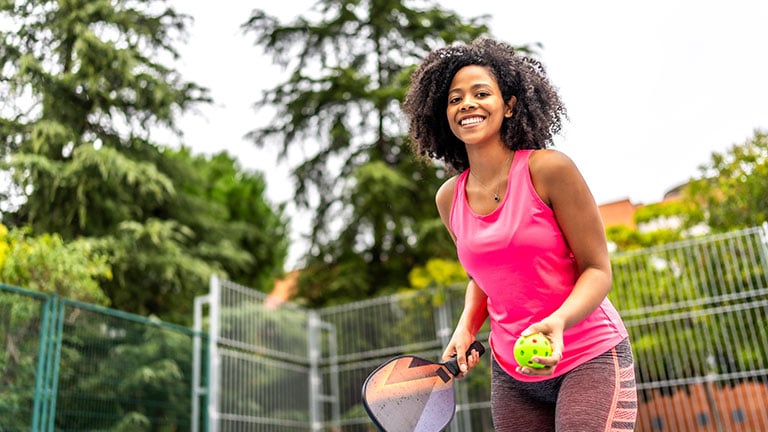

Pickleball—the fun game with the funny name—is the fastest-growing sport in the US for the fourth consecutive year, with nearly 20 million pickleball players, according to the Sports & Fitness Industry Association’s (SFIA) Topline Participation Report for 2025. That’s up a whopping 300-plus percent over the past three years. And the Association of Pickleball Professionals (APP) puts that figure even higher, reporting that more than 48 million adult Americans played pickleball at least once in the previous 12 months when it conducted its most recent study in 2023.
The growth of the sport shows no signs of slowing, either, says Alex Kerman, the SFIA’s senior director of Business Operations & Research.
“During the pandemic, pickleball emerged as a standout sport, perfectly suited for outdoor play and small-group participation. Its rapid rise was fueled by its accessibility—you could play in a driveway, at a local park, on a court, or in a gym,” says Kerman. “Pickleball is social, fun, easy to learn, and relatively quick to get good at, which makes it appealing to a wide range of age groups and skill levels.”
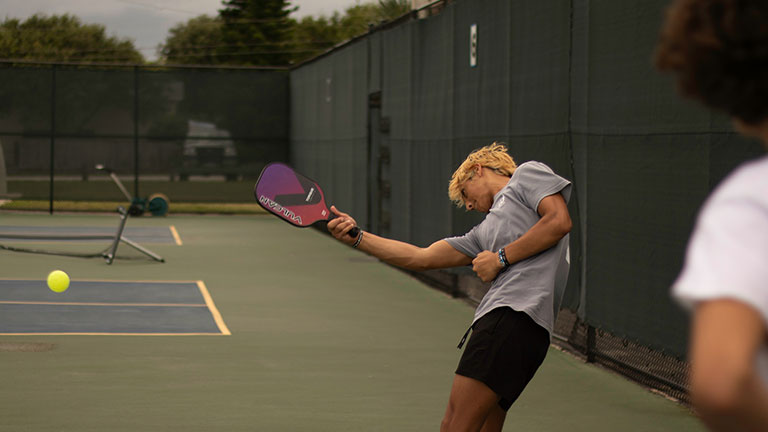
That’s right: It’s just not “older” people playing the game. (And who defines what “old” is anyway?) While the 65-and-over set composes the second-largest demographic of the sport, the largest group of pickleball players is made up of those ages 25 to 34, according to the SFIA. APP research shows the average age of today’s pickleball player to be just shy of 35, trending down from an average age of 38 in 2021. So, what’s often perceived as a sport for seniors is actually booming among millennials.
“We expect [pickleball] participation to keep climbing, especially among youth,” says Kerman. “High school and college club teams are appearing nationwide, and it's likely that pickleball will become an official sport at both levels in the near future.”
Indeed, part of the beauty of Pickleball is its cross-generational appeal, says Ken Herrmann, founder of the APP Tour, which presents both professional and amateur pickleball events worldwide. Along with being easy to learn, “pickleball is not expensive to play, the community is very friendly, and pickleball is [good] exercise,” says Herrmann, adding that it’s a family sport.
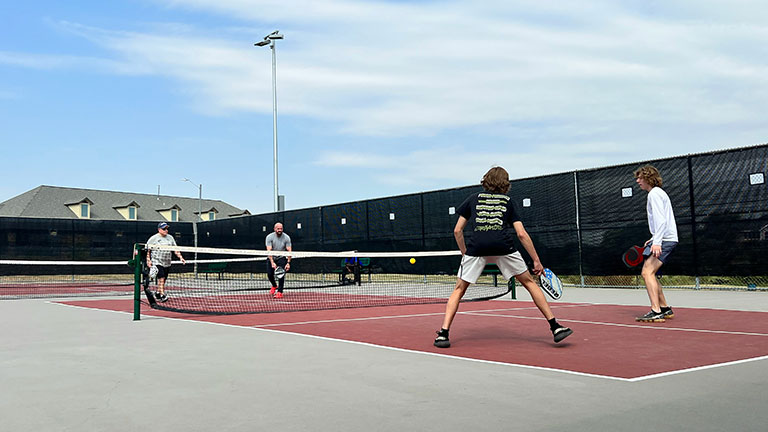
A sport is born
While its popularity is suddenly surging, pickleball is not a new sport. In fact, the game—often described as badminton meets tennis meets table tennis—was invented back in 1965 by three dads—Joel Pritchard, Bill Bell, and Barney McCallum—as a boredom-busting activity for their kids to do in the backyard of then-Congressman Pritchard’s home in Bainbridge Island, Washington.
The story goes like this: Pritchard and Bell returned home from golfing one Saturday to find their children lazing around looking for something to do. The property had a badminton court, but they couldn’t find enough racquets, so they improvised with table tennis paddles along with using a perforated plastic ball and fashioning a lowered net. The next weekend, McCallum got in on the game, and the three drafted rules, drawing chiefly from badminton. Seven years later, the trio formed a corporation to protect the sport, and—voilà!—pickleball was born.
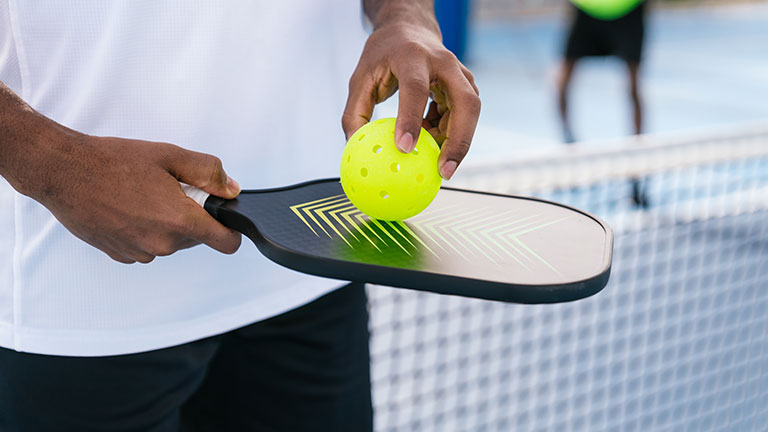
The name of the game
So, you’re probably wondering: Where did the name pickleball come from, and what does the game have to do with the iconic condiment?
The answer to your second question is “absolutely nothing.” The answer to your first question requires a small detour.
A myth that the sport was named after the Pritchard family’s dog, Pickles, circulated for years, but that story—although perpetuated by Joel Pritchard himself for a time for the sake of a good story—has been debunked. In fact, the game was invented and named several years before Pickles was even born—which the folks at Pickleball Magazine researched, confirmed and declared: case closed.
Credit for the name goes to Joan Pritchard, Joel’s wife. A rowing fan, Joan made the connection between the “pickle boats” in college crew races—that is, the nonstarting rowers from different colleges who’d pile into pickle boats and race just for fun—and the hodgepodge nature of the dads’ newfangled game. She called it “pickle ball,” and the name stuck—to the game and, years later, to the family dog.
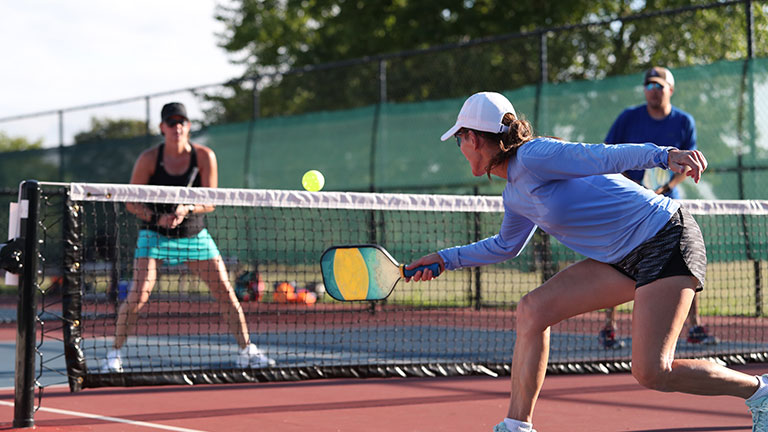
Getting in on the action
If your interest in playing pickleball is now piqued, it’s relatively easy to get in on the game.
“There are several easy ways to get started with pickleball: Take a lesson or clinic, join a beginner league, play with a friend, or find a local drop-in session for newcomers,” says Kerman. “As for equipment, you'll typically need to bring your own paddle and possibly your own pickleballs—depending on the setting.”
Digital platform Pickleheads, a community of nearly a half-million pickleheads (i.e., pickleball enthusiasts) and resource for all things pickleball, can help you locate courts from among tens of thousands of listings (and growing), organize games, book lessons, and even find players. It also provides instructional videos and the basic rules of playing for a quick primer.
Pickleball may look a bit like tennis, but it’s an entirely different game with different rules—and provides a much lower-impact workout. Like tennis, pickleball is played indoors and outdoors and as a doubles sport (most typically) or a singles sport. But pickleball courts are badminton-size (44’ x 20’)—about a third of the size of a tennis court—and have a lower net—about 6 inches lower. The rules surrounding serving and volleying differ, as does the actual stroke technique. Pickleball also has a vocabulary all its own, like dinks (a soft shot played close to the net), falafels (dead paddle or short shots), and the kitchen (the non-volley zone).
Tennis skills are transferable to pickleball, of course, but no experience is necessary to play. And while there’s a relative ease of entry, pickleball is still a competitive sport. In fact, pickleball is often described as “easy to learn, difficult to master.”
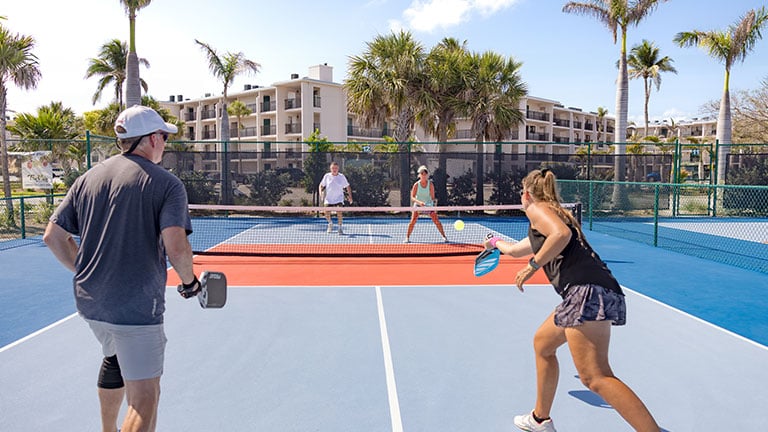
Extended play
Pickleball’s popularity translates to a plethora of places to play—including a growing number of resorts that not just have a de facto pickleball court but play up pickleball as part of the vacation experience—oftentimes against the backdrop of a beautiful natural setting.
Sandals, for example, is the first Official All-Inclusive Resorts of USA Pickleball, the sport’s governing body. Curated programming (think complimentary intro to pickleball group sessions and daily pick-up-and-play opportunities), expert instruction, top-of-the-line equipment, and some 64 premium pickleball courts are featured at 14 select Sandals resorts in the Caribbean.
Here in the US, Florida boasts pickleball opportunities aplenty, claiming more pickleball courts than any other state, reports Pickleheads. Add to that the activity-rich, sun-soaked resorts to round out the vacation experience, and it’s a win-win.
“Pickleball is a big hit in Florida thanks to our fantastic weather that allows for play all year round,” says Brad Thompson, pickleball program director and IPTPA certified instructor at Sundial Beach Resort & Spa on Sanibel Island. “Vacations at pickleball resorts offer the best of both worlds: recreation and relaxation.”
Case in point: Along with a pickleball programs offering open play, lessons, clinics, exhibitions, camps, and tournaments on 16 courts, Sundial offers guests complimentary access to paddleboards, sea kayaks, bikes, beach volleyball, and tennis.
Here in the US, Florida boasts pickleball opportunities aplenty, claiming more pickleball courts than any other state, reports Pickleheads.
Farther south on Florida’s Gulf Coast, tony Naples is often referred to as the Pickleball Capital of the World. Not coincidentally, it's also home to the National Pickleball Center with 65 courts hosting everything from open play to pro tournaments, including the US Open Pickleball Championships.
On the East Coast, Fort Lauderdale popped onto the pickleball map in a major way with The Fort, a new “social sports” destination just down the road from the Fort Lauderdale International Airport. The Fort features 43 regulation courts, the world’s first dedicated pickleball stadium, a lakeside beach, watersports, and a menu of specialty beverages and made-from-scratch cuisine.
“Eatertainment” concepts are increasingly gaining traction in the pickleball world, bringing visitors together to eat, drink and dink. Leading among them is Chicken N Pickle, an indoor/outdoor entertainment complex that serves as a huge hangout space with yard games, craft beverages, and chef-driven dishes infused with locally sourced ingredients (and wood-fired rotisserie chicken, of course). More than a dozen locations are scattered throughout the country, mostly concentrated in the Midwest.
Pickleball, after all, is a highly social sport.

From the backyard to the big time
Pickleball is a spectator sport, too, with more and more players taking their skills to the next level in pro tournaments across the country and around the world. Bolstering its reputation as a serious professional sport, a growing number of sports figures—Patrick Mahomes and Tom Brady among them—are backing Major League Pickleball teams, too.
While not an Olympic sport yet, pickleball is poised to make it into The Games soon, says Kerman. “I believe pickleball has a strong future [in the Olympics], too. While there’s a possibility it could be included in the 2032 Games, my prediction is that it will make its Olympic debut in 2036,” he says.
Who would have thought an impromptu game cobbled together to beat some summertime blues in a Washington backyard would come this far and bring so many people together in a fast-growing sport that’s even more fun to play than it is to say.
Let’s play pickleball!
